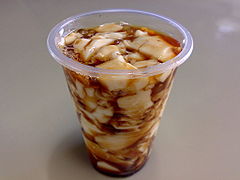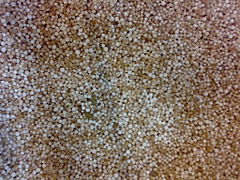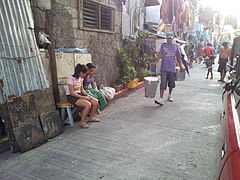- Taho
-
Tahô 
A Php 5.00 to Php 10.00 cup of tahô (about USD 11 cents to USD 22 cents)Origin Alternative name(s) Tahu Place of origin Philippines Dish details Course served Dessert, Snack Serving temperature warm / room temperature Main ingredient(s) Silken tofu
Brown sugar syrup
Sago "pearls"Approximate calories per serving 323[1] Tahô is a Philippine snack food made of fresh soft/silken tofu, arnibal (brown sugar and vanilla syrup), and pearl sago (similar to pearl tapioca).[2] This staple comfort food is a signature sweet and can be found all over the country. The Indonesian and Malaysian equivalent of this dish is Tahu.[3]
Contents
History
Through early records, it is evident that tahô traces its origin to the Chinese douhua. Prior to the Spanish Colonization, Chinese were common traders with the natives, influencing Philippine cuisine.
Processing and preparation
Most tahô vendors prepare their goods before dawn. The main ingredient, fresh soft/silken tofu is processed to a consistency that is very similar to a very fine custard. Brown sugar is then heated and caramelized to create a viscous amber-colored syrup called arnibal. Sago "pearls," purchased from the local market or palengke, are boiled to a gummy consistency until they are a transluscent white.
Marketing
The Magtatahô (taho vendor) is a common sight in the Philippines. A magtatahô carries two large aluminum buckets that hang from each end of a yoke. One of the buckets (the larger one) carries the tofu base; the other, smaller bucket holds the arnibal and sago "pearls".
Tahô vendors peddle their product in a distinctive manner, calling its name in a full, rising inflection as they walk at a leisurely pace either along the sidewalk or, in rural communities, in the middle of the road. As most magtatahô keep a habitual route, it is not uncommon for vendors to call out "Tahoooooô!" to attract a customer's attention. Though vendors are most likely to ply their routes early in the morning, it is not uncommon for a magtatahô to be spotted in the late afternoon or the evening as well. This is particularly common in the heart of Manila, most particularly by Manila Bay.
In Baguio, there is also a strawberry variety of taho, wherein strawberry syrup is used instead of arnibal. Other varieties are in chocolate and buko pandan flavor.
Eating
Most magtataho carry plastic cups for their product, often in two sizes (though vendors in residential communities tend to use their customers' cups and price their product accordingly). Using a wide, shallow metal sandok or scoop, they skim the surface of the bean curd and toss out any excess water, subsequently scooping the bean curd itself into a cup. Then, using a long, thin metal ladle, they scoop sago or tapioca "pearls" and arnibal into the cup, loosely mixing it in.
Tahô is enjoyed either with a spoon, sipping it with a straw, or by simply slurping it straight from the cup. Though traditionally served warm, cold varieties exist in supermarkets and in food stalls in cafeterias which have the bean curd in a solid, unbroken state. These pre-packed cups tend to contain a firmer tofu which need to be broken up and is sold either with a plastic spoon or a wooden popsicle stick.
See also
Footnotes
- ^ "Taho: Nutrition Facts". http://www.recipezaar.com/298213. Retrieved 2008-07-16.
- ^ "How to make Taho". Archived from the original on 2007-05-03. http://web.archive.org/web/20070503151341/http://www.tahoonline.info/howto.html. Retrieved 2007-05-05.
- ^ Davidson, Alan (2003). Seafood of South-East Asia. Ten Speed Press. p. 214. ISBN 1580084524. http://books.google.com/books?id=8nhfSFs79fUC&pg=PA214&dq=taho+Philippines&lr=&sig=LKXkZgu4Qv8UyyinD-Vxh8p5DUI.
Categories:
Wikimedia Foundation. 2010.


